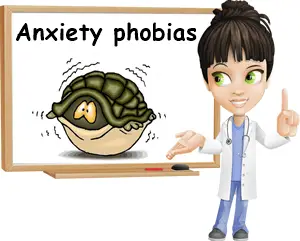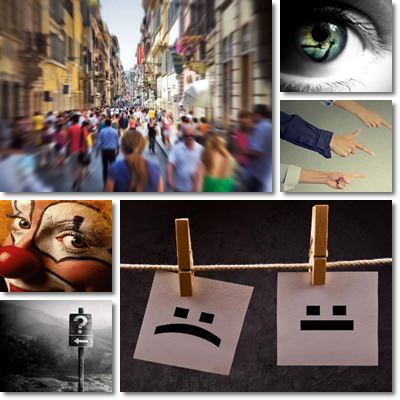By definition, anxiety means experiencing uneasiness or fear over future events or situations, real or imagined. Depending on the object of one’s fear, several different types of anxiety disorder can be identified. An example is anxiety directed at specific fears and known as phobia disorder. Common phobias include the fear of heights, clowns, flying, agoraphobia etc. Anxiety that culminates with paralyzing fear that prevents one from functioning both physically and mentally is known as panic disorder.
Generalized anxiety disorder is a more general type of anxiety characterized by continual worry or fear of potential misfortune. Overall, there are about 7 major types of anxiety disorder, each with a distinctive set of triggers. The object of one’s fears is what generally determines the best course of treatment for each type of anxiety. For example, while phobias are best resolved by facing one’s fears, post traumatic stress often requires medication and therapy, while obsessive-compulsive disorder treatment is successful mostly when there is intrinsic motivation to overcome certain habits.

How does anxiety work? Our brain works by making connections of all sorts. A bad smell to food tells us to not eat that food because it might harm us, cold makes us put on more clothes, while a bad experience may have us fearful of things connected to it and avoid what our brain believes to have caused or build up to it. This explains how anxiety works and why sufferers can’t just get over it. It is absolutely normal to associate fear, worry or anxiousness with an infelicitous experience because this is our brain’s way of teaching us to avoid something that might harm us. However, fear of something becomes pathological when it is excessive and this is when anxiety in its different forms occurs. The following are the most common 7 types of anxiety.
Main types
1) Generalized anxiety disorder. This particular type refers to experiencing continual, unspecific anxiety with regards to countless possible unfortunate outcomes of daily situations. In generalized anxiety disorder, there is a constant tension, ongoing worry and fear towards everything. Daily life with everything it implies is cause for anxiety and we may become overly anxious over small things such as having to wake up early to go to work, the possibility of missing our bus, meeting deadlines at work, when or what to eat, interacting with colleagues at work, seeing a superior walk by, household chores, responsibilities, making and keeping appointments, taking care of others, the possibility of something unexpected, not necessarily unfortunate happening, the unknown.
The anxiety targets every aspect of one’s life: personal relationships, family, work, school, friends, social events, finances, health etc. According to textbooks, excessive worrying for more than 4 to 6 months can indicate generalized anxiety disorder. Both children and adults can have generalized anxiety, but it is much more common in adults. Also, women are more predisposed to anxiety in general. Signs and symptoms of anxiety include overthinking, excessive preoccupation, restlessness, nervousness, tension, irritability, sleep problems, confusion, palpitations, shallow breathing, profuse sweating, lightheadedness etc.

2) Social anxiety disorder. Unlike generalized anxiety disorder, social anxiety is directed at social interaction. The main coping mechanism is avoidance. Basically, someone suffering from social anxiety will avoid making appointments or plans that involve other people or leaving the safety of their home, keeping appointments, taking part in group discussions or activities, speaking in public etc. Missing work and school or postponing things are common.
Since social interactions are impossible to avoid forever and the thought of the inevitable occurring is too much to consider, social anxiety sufferers may resort to dangerous coping mechanisms in the form of various addictions. Alcohol addiction or abuse of certain medicines can momentarily reduce the stress of a situation, but as soon as their effects wear off, anxiety becomes overwhelming and crippling once again.
Social anxiety is actually a form of phobia. You are basically afraid of social situations and the reasons for this phobia are generally the fear of being judged or belittled, the fear of being rejected, the fear of being humiliated or the fear of having any form of social interaction. Social anxiety may or may not stem from past negative experiences or self-consciousness about how you look, talk, behave etc. Avoidance ultimately leads to isolation and becoming dysfunctional in a social setting.
3) Phobias. They are a more specific form of anxiety in which sufferers project their fears onto a particular object, situation or living being which becomes the trigger for the phobia. It can take the form of driving anxiety, flying anxiety, reptile phobias, spider phobia, fear of heights, closed spaces, crowded spaces, open spaces, clowns, blood etc. The anxiety is triggered in anticipation of coming into contact with the object of one’s fears and is most intense in its presence, often becoming debilitating. Phobias often occur as a result of a traumatic event or an event that is perceived to pose a greater danger than it actually does.
Being involved in a car accident may trigger a fear of driving, getting stuck in an elevator may create a fear of closed spaces, getting scared by a clown as a child might generate a fear of clowns and so on. Generally, people with phobias find their fear may be excessive, but nonetheless cannot help feeling absolute dread in the proximity or presence of the object of their fears.
Agoraphobia is a common phobia and is characterized by an irrational fear of places the sufferer is not familiar with or has little control over. It is common for people with agoraphobia to fear large, open, crowded spaces or unknown locations. Agoraphobics often have comfort zones or safety havens, usually their own homes and become overly attached to them. Agoraphobia is a complex phobia that associates with various other phobias such as the fear of death (because going to an unknown location means you are not familiar with escape routes or safety areas in case something goes wrong). It is not uncommon for agoraphobics to have panic attacks.
4) Obsessive compulsive disorder. Anxiety in itself presupposes having repetitive, obsessive thoughts of misfortune. It is this obsessing that can project onto various aspects of our lives and become so rooted that it can turn into a coping mechanism, often for anxiety itself. Repeating certain actions compulsively is meant to reassure and calm us. Not keeping to behavior patterns can have us fear that something unfortunate might happen. Each person with obsessive compulsive disorder has their personal behavior patterns, most of which are directed at daily affairs.
It is not uncommon for obsessive compulsive individuals to stick to strict schedules, compulsively clean their homes or have behavior peculiarities, some related to certain numbers: saying certain things three times, checking the stove is off two times, locking the door three times to make sure it will hold, using certain products in a certain order, eating or sleeping rituals etc. Different behavior patterns are linked to different fears (what might happen if you don’t do something a certain number of times). After a while, it’s no longer the behavior itself that brings reassurance and gratification, but rather satisfying the compulsion.
5) Panic disorder. Panic disorder is when you have panic attacks triggered by the object of your fears. A panic attack is something more than anxiety, more than fear. It’s the palpable experience of intense fear, of terror. It occurs unexpectedly and is overwhelmingly intense, with symptoms being more evident than those of various anxiety disorders. Panic attacks may occur with other anxiety disorders, signaling an escalation of fear and symptoms match this rise in intensity.
Panic attack symptoms are shorter, but more intense and often take the form of shallow breathing, palpitations, increased heart rate, chest pain, nausea, profuse sweating, mental fog, dizziness, overwhelming apprehension, trembling or muscle tension, detachment from reality (derealisation). Traumatic events, coffee and alcohol consumption, certain medications such as sedatives may all contribute to panic attacks. Therapy and medication may be recommended for the condition.
6) Post traumatic stress disorder. It refers to the distress experienced following a traumatic event. Any traumatic event that can be felt as a threat to one’s life can cause significant distress weeks, months and even years following the event and trigger post-traumatic stress. The fear of the event reoccurring as well as reliving the event from memory can keep the fear alive and feed the post traumatic stress. Nightmares of a traumatic event, obsessive feelings and thoughts of a traumatic event, hyper-vigilance, physical and mental distress are common symptoms.
7) Separation anxiety disorder. It is not uncommon for us to get overly attached to various objects or places or certain people which offer us an undisturbed sense of security. And it’s perfectly natural to not want to have these objects, places or people taken away from us. If this happens, separation anxiety may occur. The condition is statistically more common in children, and increasingly more common in adults. Symptoms of separation anxiety may take the form of panic, irrationality, crying, nausea, stomachaches, vomiting, temper fits, physical overexertion, but also distress in anticipation of the separation, anxiety over a future or potential separation or nightmares about the separation.
A child might experience anxiety separation when a favorite toy is taken away or lost, in the absence of an adult they are overly attached to, if they have to spend time away from home, sleep in another bed or place (this is common in adults with separation anxiety as well) etc.
Conclusion
Everyone dealing with anxiety responds in a particular way to its challenges. Given that the disorder itself is of a sensitive nature, blunt approaches that disconsider the feelings of sufferers or the sensitive nature of the disorder are more likely to make anxiety worse. Disconsideration, refusing to acknowledge anxiety is overpowering or belittling ts psychological and physical symptoms does not help the sufferer recover or want to. Showing support and understanding and being perseverant in your efforts to help are the pillars of the recovery process irrespective of the type of anxiety one is suffering from.
